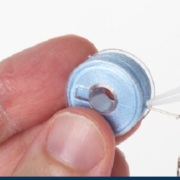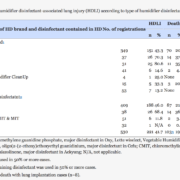Test your Uroshiol Savvy
/in Allergic Contact Dermatitis Facts/by Sharon Jacob MDTest your knowledge of common items containing the allergen Uroshiol
FDA data on the TRUE Test
/in Allergic Contact Dermatitis Facts, Regulation and Policy/by Sharon Jacob MDThis article updated in Nov 2015 on the Thin-layer Rapid Use Epicutaneous (T.R.U.E.) test discusses Indications and Usage, Dosage and Administration, and Contraindications, Timing of the Reads, Interpretation Instructions — use in specific populations (pregnancy, nursing, pediatric) — detailed allergen composition and the ten clinical studies were conducted in North America and Europe evaluating sensitivity and specificity, and/or agreement with a reference allergen…
To read full article: http://www.fda.gov/downloads/BiologicsBloodVaccines/Allergenics/UCM294327.pdf
High concentrations of isothiazolinone and mislabeling – Belgium
/in Regulation and Policy/by Sharon Jacob MDThis article discusses the evaluation of MI in products in Belgium and the verification of accurate labeling and regulatory compliance. They found that concentrations of MI may be “(too) high” and labelling may be incorrect.
“Aerts O1, Meert H2, Goossens A3, Janssens S2, Lambert J1, Apers S2. Methylisothiazolinone in selected consumer products in Belgium: Adding fuel to the fire? Contact Dermatitis. 2015 Sep;73(3):142-9. doi: 10.1111/cod.12449.
Methylisothiazolinone (MI) contact allergy is severely affecting consumers with allergic contact dermatitis, owing to its presence in cosmetics, household detergents, and water-based paints, in particular. Data on the true isothiazolinone concentrations in these products are scarce, and labelling may be incorrect.”
“OBJECTIVES:
To report on the MI concentrations in such products marketed in Belgium, in order to verify the accuracy of labelling (when applicable) and compliance with EU regulations.
MATERIALS AND METHODS:
Thirty cosmetics (18 leave-on and 12 rinse-off), eight detergents and four paints were analysed for MI by the use of high-performance liquid chromatography with ultraviolet detection.
RESULTS:
The analysed leave-on, and to a lesser extent the rinse-off, cosmetics, contained MI at concentrations far exceeding the permitted 100 ppm use concentration. Household detergents contained high concentrations of MI, and mislabelling occurred for both cosmetics and detergents. The (limited) data on paints are in line with the existing literature.
CONCLUSION:
Cosmetics and detergents may facilitate contact sensitization because of a (too) high MI concentration, and mislabelling may make its avoidance extremely difficult. Safer use concentrations and correct labelling should be ensured by adequate quality control.”
This is not an OPEN ACCESS article. The article can be rented at: http://onlinelibrary.wiley.com/wol1/doi/10.1111/cod.12449/full
Free Article: MCI-MI ‘Outstanding Emerging Allergen’ Thailand
/1 Comment/in Allergic Contact Dermatitis Information/by Sharon Jacob MDThis article from King Chulalongkorn Memorial Hospital in Thailand compares the authors patch test result between current (2012-2015) and their prior report (2003-2004). The authors named MCI-MI an “outstanding emerging causative allergen” in their current clinical experience and found MCI-MI to be the most common preservative causing contact allergy (formaldehyde is second). The MCI-MI prevalence was found to be related to personal care products. Also of importance, the prevalence of paraben (another preservative) allergen dropped possibly related to decreased exposure and decreased use in products.
Patterns and risk factors of causative contact allergens in Thai adult patients with contact dermatitis at King Chulalongkorn Memorial Hospital. Dararattanaroj W1, Pootongkam S, Rojanawatsirivej N, Wongpiyabovorn J. Asian Pac J Allergy Immunol. 2016 Jun 30. doi: 10.12932/AP0757.
“BACKGROUND:
Surveillance on common allergens identified by patch testing plays an important role in emerging allergen detection, which leads to both individual and societal level prevention.
OBJECTIVE:
To study the changes in the pattern of contact sensitization and to identify risk factors associated with allergens.
METHOD:
The data of 206 patients who underwent patch testing at King Chulalongkorn Memorial Hospital during 2012 to 2015 were assessed. The associations between patient risk factors and positive reactions to each allergen were evaluated. The results were compared with data from 2003-2004.
RESULTS:
The top five most common allergens during 2012-2015 were nickel sulfate (19.4%), methylchloroisothiazolinone/ methylisothiazolinone (MCI/MI) (13.6%), fragrance mix I (FM I) (10.7%), carba mix (9.2%) and cobalt chloride (6.3%) whereas, during 2003-2004, these were nickel sulfate, cobalt chloride, FM I, potassium dichromate and Myroxylon pereirae. A positive patch test to nickel was strongly associated with a history of metal and seafood allergy (p±0.001; OR, 4.94; 95% CI = 2.33-10.47 and p=0.028; OR, 2.55; 95% CI, 1.11-5.85, respectively). MCI/MI was correlated with a history of personal care products allergy, and fragrance was correlated with a history of urticaria (p=0.005; OR, 4.05; 95% CI = 1.54-10.66 and p=0.031; OR, 2.71; 95% CI, 1.10-6.68, respectively).
CONCLUSIONS:
There was an alteration in the pattern of contact sensitization detected by our standard series. MCI/MI has become the most common preservative causing contact allergy.”
Link here to read the full OPEN ACCESS article:
http://thailand.digitaljournals.org/index.php/APJAI/article/viewFile/29955/30258
To learn more about the second methylisothiazolinone epidemic – click here:
https://www.dermatitisacademy.com/wp-content/uploads/2016/05/Update-on-Isothiazolinones.pdf
Also:
Bunyavaree M1, Kasemsarn P1, Boonchai W1. Cosmetic preservative labelling on the Thai market.
Contact Dermatitis. 2016 Apr;74(4):217-21. doi: 10.1111/cod.12520. Epub 2016 Jan 22.
” International brand cosmetics were more likely to contain non-formaldehyde-releasing preservatives than domestically produced brands. Isothiazolinone-based preservatives, which are responsible for the current increase in the prevalence of contact allergy, were found at a significant frequency in domestically produced, leave-on cosmetic products.”
Free Article – American Contact Alternatives Group (ACAG) – Miscellaneous
/in Allergic Contact Dermatitis Information/by Sharon Jacob MDPart 4 of a 4-part series Miscellaneous Products:
Scheman A, Jacob S, Katta R, Nedorost S, Warshaw E, Zirwas M, Selbo N.Trends and Alternatives in Deodorants, Antiperspirants, Sunblocks, Shaving Products, Powders, and Wipes: Data from the American Contact Alternatives Group.J Clin Aesthet Dermatol. 2011 Oct;4(10):35-9.
“To provide updated data on the usage of ingredients that are common potential contact allergens in several categories of topical products. To identify useful alternative products with few or no common contact allergens….Percentages of American Contact Dermatitis Society core series allergens (and other common preservatives and sunblocks) were calculated….Data on allergens and alternatives for ancillary skin care products are not widely published. This article reviews some of the common potential allergens in antiperspirants, deodorants, shaving products, sunblocks, powders, and wipes. Suitable available alternative products for patients with contact allergy are listed.”
Free Access to the article here:http://www.ncbi.nlm.nih.gov/pmc/articles/PMC3196302/
Methylisothiazolinone and Fragrance mix sensitization in Iranian Children
/in Uncategorized/by Sharon Jacob MDThe MI and the fragrance mix related chemicals are frequently used in personal hygiene products marketed for children.
Patch testing in Iranian children with allergic contact dermatitis
Hossein Mortazavi, Amirhooshang Ehsani, Seyed Sajed Sajjadi, Nessa Aghazadeh, and Ebrahim Arian
BMC Dermatol. 2016; 16: 10. Published online 2016 Jul 12. PMCID: PMC4943022
“Background”
“Allergic contact dermatitis is a common disorder in adults and children alike and appears to be on the increase. The purpose of this study was to determine the sensitization trends in Iranian children with contact dermatitis.“
“For most allergens (except cobalt chloride, methylisothiazolinone, paraben mix, and fragrance mix), the percentages of positive response in the older age group (11–18 years) were higher than children below 10 years. The most common allergen in the younger age group were cobalt chloride (4, 18.2 %), nickel sulfate (3, 13.6 %), methylisothiazolinone (2, 9.1 %), and paraben mix (2, 9.1 %) while in the older group they were as follows: nickel sulfate, cobalt chloride, methylisothiazolinone, colophony, potassium dichromate.“
Read more here:http://www.ncbi.nlm.nih.gov/pmc/articles/PMC4943022/
lung injury and humidifier disinfectant – MI! Free article
/in Uncategorized/by Sharon Jacob MDMajor concerns regarding lung injury and related health conditions caused by the use of humidifier disinfectant.
Abstract
A total of 221 patients were evaluated to be humidifier disinfectant associated with lung injury (HDLI) through two rounds of programs through April 2015. The humidifier disinfectant (HD) brands most often associated with HDLI were found to be Oxy (n=151, 68 %) and Cefu (n=26, 17 %). Polyhexamethylene guanidine used for disinfectant for four types of HD brands including Oxy was found to be associated with the highest number of HDLI cases (n=188). Further programs are operating to identify various health effects including lung injury which may be associated with the use of HD. Not only national agencies, but also pertinent environmental health societies should cooperate in the necessary investigations so that this tragedy can be properly addressed and future incidents concerning chemicals and chemical-containing products can be prevented.
KEYWORDS:
Chloromethylisothiazolinone; Methylisothiazolinone; Oligo(2-)ethoxyethoxyethyl guanidine chloride; Polyhexamethylene guanidine; humidifier disinfectant; lung injury
Read more here: http://e-eht.org/journal/view.php?doi=10.5620/eht.e2016014
Introduction:
“Korean authorities recently completed two rounds of programs (first: July 2013 through April 2014; second: July 2014 and April 2015) in an effort to examine the association of humidifier disinfectant-associated lung injury (HDLI) with the use of humidifier disinfectant (HD) by collecting information on individuals with lung injury who presumed their condition to be related to the use of HD and determining whether these registered cases were indeed associated with the use of HD. A total of 221 were evaluated as being associated with use of HD, including interstitial pneumonitis and widespread lung fibrosis, necessitating lung transplantation for some.” … “In 2012, two HDLI patients aged one year who were exposed to the Aekyung brand of HD containing a mixture of CMIT and MIT that had been exempted from the recall list were evaluated to be HDLI victims.”
Table 1 discusses the Distribution of humidifier disinfectant-associated lung injury (HDLI) according to type of humidifier disinfectant (HD) and disinfectant… 51 registrants used 6 had HDLI. 2 died.
Conclusion:
“The tragedy caused by household use of HD products cannot be resolved within a short period of time. It will require considerable time and effort to identify the victims, compensate them for damages, delineate the exact causes and take appropriate measures to prevent any recurrence of incidents caused by household products. Not only national agencies, but also pertinent environmental health societies should cooperate in the necessary investigations so that this tragedy can be properly addressed and future incidents concerning chemicals and chemical-containing products can be prevented.”




